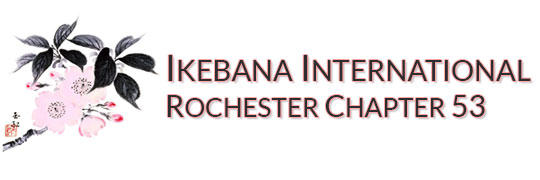
Chabana (literally in Japanese this means, “tea flowers”) is the term for the flower arrangements offered during the Japanese tea ceremony. The way these arrangements are made follows the “thrown in” style where the arrangement appears to be as though someone just came in from the outside after snipping the materials and threw them in the container. But much more thought and planning goes into making these types of arrangements. The arrangement emphasizes what the tea ceremony is trying to do which is simplify one’s experience of the moment and bring the mind’s focus on the infinite richness and fullness of the moment.

Chabana grew out of the practice of ikebana which had its beginnings in altar flower offerings in Buddhist monasteries. However, chabana eventually developed into its own separate genre. These arrangements are usually only seen in a room or space for chado (tea ceremony).
The history of chabana naturally followed the history of chado. The most influential
person in the development of this type of flower arrangement was Sen no Rikyu. This style is characterized by freedom and spontaneity in expressing the natural beauty of the materials.
This style of flower arranging has fewer rules and uses less materials than most other forms of ikebana. The major schools of ikebana can have large, complicated arrangements using many materials and following many rules. Thus this type of flower arranging appeals to those who

are looking for a more simple, but rich natural appearance. Over time this simple, spontaneous method of flower arranging became the standard for the Japanese Tea Ceremony.

The chabana arrangement is one of the main focuses during the tea ceremony. It is usually displayed in the tokonoma or other area set aside for displaying the main theme or idea of the
event. The main item expressing this theme would be the kakemono or wall hanging or scroll featuring a Zen phrase or similar phrase written in brush and black ink. The chabana arrangement compliments this theme.
There are minimal rules for making these arrangements which appears to those who have a preference for a simple, natural look. The materials used in these arrangements follow what one would see in that season of the year. Usually the containers are simple vases or baskets–nothing flashy or complicated. Glazed and unglazed

ceramics as well as bamboo are used for the vase arrangements. Sometimes glass may also be used. However, depending on how formal or relaxed the environment is for the tea ceremony, the arrangement should also express that degree of being formal or informal.

In making the arrangement, the materials are selected first and then the containers. The feeling of viewing the arrangement should be similar to what one would have when viewing them in a natural setting.
Even though there are minimal rules, some of the rules deal with what materials not to use such as flowers
with unpleasant names, or materials with unpleasant or strong odors. Flowers with no particular seasonality and blossoms which are long lasting are not used.
